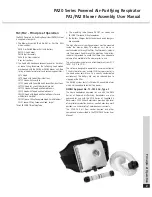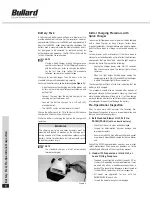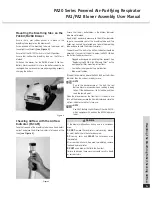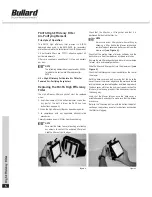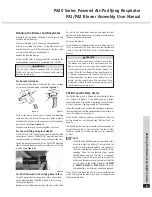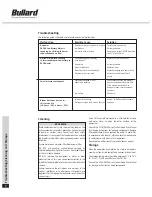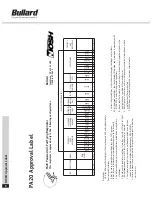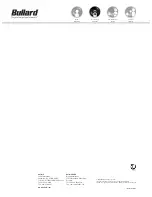
TM
Battery P
a
ck/Pr
e
-Oper
ational Inspection
3
The charging port plug and cover assembly must be
mounted and locked in position on the charging port
during use and at all times except when recharging the
battery. Failure to follow these instructions could result
in death or serious injury.
WARNING
Battery Pack
A fully charged battery pack will power a blower unit to
provide adequate air volume for the respirator hood for
approximately 10 hours for the PA1BU, and approximately 6
hours for the PA2BU, under normal working conditions. The
battery pack is mounted inside the blower unit body and is
not designed to be removed or replaced except by
authorized service personnel. The ON/OFF switch must be
in the OFF position for re-charging.
NOTE
If using a Quick Charger or Gang Charger, please
see the instructions in “Initial Charging Procedure
with Quick Charger” prior to charging the battery
for the first time. Also, follow this procedure
following periods of extended storage.
Charging for periods longer than 16 hours with the
standard charger will reduce battery capacity.
To charge the battery pack, do the following
(see Figure 1)
:
• Open the cover on the charging port of the blower unit
by turning the retaining collar counter-clockwise and
pulling it off.
• Connect the lead from the battery charger to the
charging port on the blower unit.
• Connect the battery charger to a 120-volt (AC)
electrical outlet.
• The ON/OFF switch on the blower must be off.
Charge the battery pack for 14 to 16 hours with standard
charger and 8 hours with quick charger.
While the battery is charging the light on the charger will
remain on.
NOTE
The standard charger will not automatically
terminate charging!
Initial Charging Procedure with
Quick Charger
To ensure a full charge on a new blower unit being charged
with a Quick Charger or Gang Charger, follow these
important guidelines. These guidelines also apply to blower
units that have been in storage for extended periods of
time.
For new blower units or blower units that have been in
storage for extended periods of time, follow the directions
above under “Battery Pack”, and when the light begins to
flash on the Quick Charger do the following:
• Unplug the charger power cord. Wait 15 seconds.
Plug the charger in again. The charger light will now
remain on.
• When the light begins flashing again, unplug the
charger power cord. Wait 15 seconds. Plug the charger
in again. The charger light will now remain on.
The charger light will flash a third time, indicating that the
battery is fully charged.
This procedure should also be followed after periods of
prolonged storage. Without periodic charging, the nickel
metal hydride batteries will lose up to 1% of their charge
per day. Allowing a battery to self-discharge during periods
of prolonged storage will not damage the battery.
Pre-Operational Inspection
Prior to each work shift, perform the following Pre-
Operational Inspection to ensure proper operation and
that you have the following items.
1. Belt Mounted Blower Unit, Part No.
PA1BU/PA2BU
(with on board battery)
• Check that the unit is clean and undamaged.
• Inspect for deterioration, physical damage, and
improper assembly.
• Ensure that a PA1FG high efficiency filter and gasket
are properly mounted and seated inside the blower
unit.
Consult the NIOSH approval label and your own in-plant
safety professional if you have any questions as to the
suitability and efficiency of the air-purifying element.
2. Hood with Suspension or Hard Hat, or
Loose Fitting Facepiece
• The hood is constructed of either Tychem® QC or
Tychem SL. Depending on the model ordered, it may
be used with either a headband suspension or a
hard hat. The loose fitting facepiece is constructed of
Tychem QC and features an internal suspension
•
All hoods are approved for use with the
PA1BU/PA2BU Blower Units.
• Inspect the hood for any physical damage.
Figure 1


